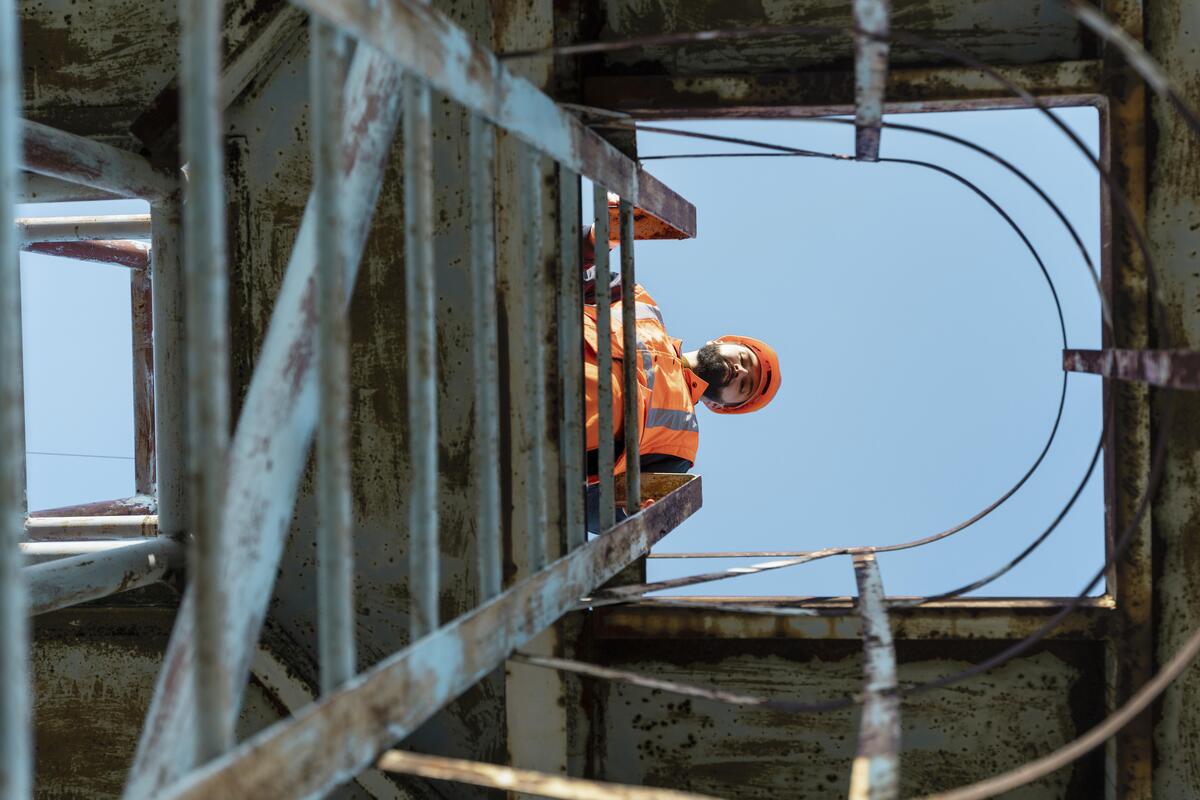Updated by Nazanin Ghodsian, 11/12/2024
“Perfection has to do with the end product, but excellence has to do with the process.” – Jerry Moran
Construction is a high-risk industry by nature, and each project has its own potential and problems. Although risk management in the construction industry can be challenging, successful risk management examples show that preemptive steps and strategic planning can make it possible.
Risk management in construction is vital; uncontrolled risks might disrupt or even derail projects. To lessen negative effects, possible hazards must be evaluated, controlled, and tracked if they are discovered. When risks are managed well, they can result in unanticipated benefits like higher sales, improved client relations, and market expansion.
Most sectors cannot compare to the wide range of dangers that construction encounters. Any unanticipated circumstance, such as a scarcity of materials or bad weather, has the potential to throw project budgets and schedules off. On the other hand, risks in other industries, such manufacturing labor disputes or agricultural pests, are typically more predictable. Therefore, construction risk management necessitates being prepared for a wide range of unforeseen circumstances. For instance, project managers frequently coordinate across several independent contractors while managing labor, weather, and supply challenges concurrently.
Knowing Risk Management Examples in construction can help project managers stay ready for these variables. Building firms can successfully manage risks and preserve project stability by taking note of these instances and putting thorough planning into practice.
Table of Contents
What is Construction Risk Management?
A method or system for identifying and minimizing different hazards within a building project is known as construction risk management.
Construction software is one tool that, if used consistently throughout the project, can help manage numerous significant risks, especially considering how difficult it is to control risk. Creating a risk-based operational excellence program can assist you in managing the full project lifecycle more effectively if you have the correct team and program in place.
We’ve outlined the primary risk categories and the top 6 dangers that, with the correct building software, you can genuinely control to help you prioritize your risk assessment.

Hazard vs. Uncertainty vs. Risk
Making the distinction between risk and hazard is critical to project management in the construction industry. A possible source of injury is called a hazard, and the chance that harm will materialize is called a risk.
To properly manage construction risks, all potential hazards must be identified, assessed, and prioritized according to their likelihood and severity. Then, appropriate mitigation measures must be put in place.
Time, money, and reputation can all be severely lost in the construction industry if risk management is neglected. If a construction project is delayed or does not adhere to safety regulations, the company may face legal challenges, reputational harm, or financial penalties.
It is essential to create and carry out risk management plans to reduce construction-related hazards. This entails locating possible risks, assessing the risks connected to those risks, and creating a strategy to reduce or eliminate those risks.
Plans for risk management that are effective should contain precautions against or mitigation of hazards in addition to backup plans for unexpected events. Understanding and managing these risks lowers the possibility of mishaps, delays, and other unfavorable effects, leading to a project’s successful conclusion.
Suggested article to read: Construction Risk Management
Importance of Risk Management in the Construction Industry
Risk management plays a crucial part in ensuring the successful execution of construction projects. Its significance cannot be emphasized because good risk management is essential to project success overall, cost control, safety, and predictability.
The following are some main justifications for why risk management in building projects is essential:
- Minimized Cost Overruns – helps identify potential cost risks early, allowing for proactive planning and allocation of contingencies to cover unforeseen expenses
- Timely Project Completion – maintains project schedules to meet contractual obligations and ensure project stakeholders’ satisfaction
- Enhanced Safety – creates a safer work environment for all involved parties by mitigating risks and developing safety plans
- Optimized Resource Allocation – minimizes resource shortages and wastage, improving project efficiency
- Improved Decision-Making – provides project managers with valuable insights into potential challenges and their consequences based on risk assessments
- Early Problem Detection – prevents small problems from snowballing into major obstacles
- Effective Change Control – helps anticipate changes and their impact, allowing for smoother integration of modifications
- Enhanced Profitability – helps protect profit margins by reducing the likelihood of costly rework, delays, and additional expenses
- Stakeholder Confidence – fosters trust and may attract further investment or collaboration
- Project Resilience – ensures that projects can navigate unforeseen circumstances with minimal disruption
13 Risk Management Examples in Construction Projects
Due to the inherent complexity of construction projects, some risks may materialize throughout the project’s lifespan and significantly affect its outcome. These risk management examples include those related to money, productivity, safety, the environment, and the law. Stakeholders can reduce possible negative effects and guarantee project success by being aware of these typical risk categories and creating efficient risk management plans. The following categories of risk management examples are prevalent in building projects:

Financial Risks
It should come as no surprise that one of the biggest “threats” to a project’s success is frequently budget overruns. Having said that, it is quite beneficial for the construction management team to accurately identify financial risks before project initiation.
These kinds of risk management examples are mostly dependent on the nature of the construction project and its location. In short, when we talk about financial hazards, these are some possible risk factors:
1. Budget Overruns due to Inaccurate Estimates or Cost Increases
This is a scenario in which a building project’s actual costs surpass its projected costs. The effective completion of building projects can be significantly impacted financially by inaccurate cost estimates or unanticipated cost hikes. These hazards could result from things like modifications to the project’s scope, shifts in the price of labor and materials, and unanticipated site circumstances. It is essential to create precise cost estimates, put in place efficient change management practices, and keep a careful eye on project expenses to mitigate these risks. Inadequate risk management may result in project delays, cancellations, or disagreements between the stakeholders.
2. Inadequate Cash Flow or Financing
One of the biggest financial risk management examples is inadequate cash flow or finance, which can be brought on by unanticipated expenses, project scope modifications, or payment delays. This risk may result in disagreements between the parties involved, the project’s suspension or termination, and harm to the project’s reputation. Creating a strong financing plan, keeping a careful eye on cash flow, and putting in place efficient payment management practices are all necessary to control this risk.
3. Supply Chain Impacts
There are major financial risk management examples associated with supply chain disruptions that impact the timely delivery of supplies, machinery, or services needed for construction projects. These disruptions can result in delays, overspending, or even project cancellation. These hold-ups may result in higher expenses and lower-quality output. Trade restrictions, supplier bankruptcies, and transportation problems are a few possible causes of these interruptions. Establishing strong ties with important suppliers, creating efficient supply chain management processes, and putting backup plans in place for any disruptions are all essential to managing this risk.
Productivity Risk Management Examples
This risk management example is anything related to project management and its smooth development. Performing a resource management analysis is likely the first thing you should do, considering staff, supplies, and tools. After defining the requirements for your project, you must assign roles and provide precise deadlines for each activity.
Always make an effort to consider the potential roadblocks that may appear along the path. That way, you’ll be ready for any kind of setback.

4. Inefficient Project Management or Coordination
The incapacity of project managers to efficiently plan, schedule, and carry out construction projects leads to ineffective project management or coordination. Numerous things, including insufficient resources, ineffective communication, and insufficient experience, can increase this risk. It is a major obstacle for building projects, resulting in higher expenses, longer lead times, and lower-quality output.
It may also lead to increased risks of accidents on building sites and safety issues. The risk of ineffective project management or coordination has become a prevalent concern in the construction sector due to a lack of uniformity in project management methods and a lack of funding for project manager training programs.
Effective project planning and execution have become more challenging for project managers due to the complexity of contemporary building projects.
5. Unanticipated Design Changes or Scope Modifications
These adjustments take place when an undertaking encounters unforeseen modifications to the initial plan or extent. These alterations may be the consequence of modifications to the project specifications, adjustments to laws, or adjustments to the client’s needs.
These risk management examples pose a significant challenge to construction projects since unforeseen scope changes or design adjustments can result in greater costs, delays, and lower-quality work.
Unexpected changes may also necessitate rework, which adds to the project’s delay and expense. A project that lacks flexibility in its plan will be more susceptible to unforeseen changes and find it more challenging to adjust to unforeseen circumstances.
6. Labor Shortages or Unavailability of Skilled Workers
Lack of skilled labor or people with the requisite training and expertise to finish construction projects is the cause of labor shortages or the unavailability of skilled personnel. Numerous factors, including changes in the job market, economic instability, and demographic transitions, contribute to this risk.
It presents a serious obstacle to building projects, resulting in longer lead times, higher expenses, and lower-quality output. The scarcity of qualified labor in the construction sector has also been exacerbated by underfunding of education and training initiatives.
Document, Legal, and Contract Risks
During the construction phase, severe disagreements can arise from contracts. You must therefore take extra time and care to ensure that every detail about contractual agreements is taken care of.
Each party’s obligations and rights must be spelled out, and every possible situation ought to have a predetermined resolution. In that regard, having an experienced legal team is always essential since they can greatly reduce any legal risks associated with your project.

7. Incomplete or Inaccurate Project Documentation
For construction projects, incomplete or erroneous project documentation poses a serious risk because it can cause misunderstandings, misunderstandings, and mistakes while the work is being done.
Project plans, scope, requirements, specifications, and any other significant project documents that are missing or incomplete are examples of incomplete documentation. Similarly, old or erroneous information, badly drawn plans, or ambiguous specifications could all be mentioned in faulty documentation.
Inaccurate or inadequate project documentation can lead to some problems, such as delays, cost overruns, project failure, or legal issues. A project team’s inability to communicate and work together, bad project management techniques, and a lack of attention to detail can all lead to incomplete or erroneous project documentation.
8. Delays in Obtaining Permits or Approvals
In building projects, delays in acquiring permits or approvals can pose serious dangers if the required permissions or approvals are not obtained from the appropriate authorities on time. This may lead to budget overruns, delays, and even project failure. A lack of planning, a poor comprehension of the regulations, or a lack of coordination and contact with the appropriate authorities all increase the chance of delays in getting permits or approvals.
Project managers need to make sure they are properly preparing and communicating with the appropriate authorities to reduce the possibility of delays in permits or approvals. This entails determining and understanding all project-related permits and approvals, creating a reasonable schedule for their acquisition, and maintaining open and honest lines of communication with the relevant authorities.
9. Disputes Over Contractual Obligations or Payment Terms
Disputes over contractual obligations or payment terms are common risk management examples in construction projects, as they can lead to delays, cost overruns, legal action, or damage to business relationships. Disputes can arise due to a failure to perform contractual obligations, disagreements over payment terms, or changing business circumstances.
Stakeholders must have a clear and comprehensive contract management system in place to reduce the risk of disputes over contractual obligations or payment terms. This includes identifying and mitigating potential disputes during the contract negotiation phase, monitoring contract performance regularly, and promptly resolving any disputes that arise.
Safety Risks
On construction sites, there are many risk management examples and hazards that construction workers must manage to protect their safety and well-being. A thorough summary of the most prevalent safety hazards in the construction sector is given by the American Industrial Hygiene Association’s (AIHA) Focus Four for Health and the Occupational Safety and Health Administration’s (OSHA) Fatal Four.

10. OSHA’s Fatal Four
- Falls: In the construction sector, falls from heights are a major source of fatalities and injuries. Without the appropriate fall protection, workers on rooftops, ladders, scaffolds, or other elevated surfaces run the risk of falling. To reduce this danger, employers must install fall protection equipment including guardrails, safety nets, and personal fall arrest devices, and provide workers with training on how to operate them.
- Struck by Object: Moving, swinging, or flying things, such as machinery, supplies, or cars, can strike workers, killing or seriously injuring them. To reduce this risk, employers must put in place controls over the movement of tools and materials, including warning signs, barricades, and personal protective equipment. Employees also need to get training on how to identify and steer clear of potential risks.
- Electrocutions: When using electrical equipment, operating near power lines, or utilizing temporary power sources, construction workers are particularly vulnerable to electrocution. Employers must implement electrical safety measures, such as hazard assessments, PPE use, and employee training on identifying and avoiding electrical dangers, to counteract this threat.
- Caught-in or Caught-between: Workers can become caught in or between equipment or objects, leading to crush injuries, amputations, or fatalities. To mitigate this risk, employers must put in place safeguards to keep employees from getting tangled in or between machinery or objects. These safeguards may include adequate guarding, lockout/tagout protocols, and employee education on identifying and avoiding dangers.
11. AIHA’s Focus Four for Health
- Noise: Extended exposure to loud noises can cause tinnitus, hearing loss, and other health problems related to the hearing system. Employers must put in place engineering controls, administrative controls, personal protective equipment, and noise control measures to manage this risk. They also need to train staff members on how to identify and steer clear of noise dangers.
- Airborne Contaminants: Exposure to dust, fumes, and other airborne contaminants can cause respiratory and other health problems. Employers must implement controls over exposure to these contaminants, such as ventilation, respiratory protection, and work procedures, and educate staff members on how to identify and prevent dangers, to take the proper action.
- Heat Stress: Employees who operate heat-generating machinery or labor in hot conditions run the risk of experiencing heat stroke and other heat-related ailments. Employers need to implement heat-related illness preventive strategies to address this risk, such as offering cooled restrooms, and water, and teaching staff members how to identify and handle symptoms of heat-related illnesses.
- Material Processing Accidents: The improper lifting, carrying, or moving of objects can result in musculoskeletal problems such as strains and sprains. To reduce this risk, employers must put in place musculoskeletal injury prevention strategies including ergonomic work practices, lifting aids, and instruction on safe lifting and carrying techniques for employees.
Environmental Risks
Natural disasters like earthquakes and floods might occasionally pose a threat to the successful completion of your project. Because of this, it is considered a “must” to analyze the environmental conditions specific to the area in which your project is being undertaken.
In this way, the project management team can take all essential precautions to safeguard the project’s advancement as well as the field personnel.

12. Adverse Weather Conditions Causing Delays or Damage
Severe weather occurrences that might cause delays or damage to building projects, such as hurricanes, tornadoes, intense heat or cold, heavy rain, or snow, are referred to as adverse weather conditions. These occurrences may result in delays in the project’s completion, which would raise expenses because more labor and supplies would be required to finish the job. They may also harm the project, necessitating expensive and time-consuming revisions and repairs. Unpredictable and potentially haphazard, adverse weather conditions pose a risk to construction projects as they can create delays or damage that could compromise the project’s overall performance.
13. Environmental Contamination or Pollution
When dangerous substances or contaminants are present in the environment or are introduced there, it is referred to as environmental contamination or pollution. Pollutants from construction operations, such as dust, noise, and chemicals, can be dangerous to the surrounding environment, the health of employees, and the welfare of onlookers. Projects involving the excavation or handling of dangerous materials, such as lead, asbestos, or mercury, carry a greater risk of contaminating or polluting the environment. Construction projects run the danger of environmental contamination or pollution since it can lead to fines, legal action, and environmental harm.
How To Manage Risks in 6 Steps
There are situations when risk management examples become a reality and could seriously harm a project. Sometimes a project fails due to some little, negligible hazards. A corporation needs to spend money on risk management if it wants a healthy growth equity curve. So how might construction risk be managed most effectively? The greatest approach is to put in place efficient procedures that enable you to make wise selections with ease. The actions you should take to control construction risk are listed below.
1. Identifying Construction Project Risks
After going over some of the typical risk management examples associated with construction projects, it’s time to determine which risks are specific to your project. This needs to be completed as soon as feasible, ideally in the project’s preconstruction stage. Recall that if you don’t recognize and address a project risk, you are essentially accepting the risk if it materializes.
To identify hazards, have brainstorming sessions with the stakeholders and the project team. You’re not trying to fix any issues at this time. Finding as many possibilities as possible that could harm the project is the aim here. Make sure you rely on your team’s knowledge base, experience, and competence.
Holding regular meetings with your project team and stakeholders is a good way to prevent risks from sneaking up on you as the project progresses. In addition to reviewing your current risk management efforts, you can use that time to identify any other issues that may come up shortly. Review past projects with similar size, scope, and location you’ve completed to understand better the construction risks your current project is facing.

2. Prioritize Risks in Order of Importance
Every company faces different risk management examples when it comes to building; a risk that affects one company may not worry you. A hurricane, for instance, could not have the same impact on your inland firm as it would on one on the shore.
It’s critical to rank your risks after you’ve identified them, taking into account both the likelihood that the risk will materialize and its possible impact on your company. Whenever possible, use numerical data for risk analysis, such as percentages and cash amounts.
Prioritize risk management examples with high impact and likelihood and address the low impact and low probability issues last. Here are a few straightforward danger scenarios along with our ranking of their priority:
- A contractor may treat a malfunctioning easily replaceable piece of equipment as low priority.
- A project material price increase that could negatively impact profit margins can be managed on a medium-priority basis.
- You can give a natural disaster a medium priority since it has a low chance of occurring but could have a high impact.
- It is imperative to give special attention to a contractor who is unable to complete their share of the project.
3. Determine your Risk Response Strategy
After determining which risk management examples are most important, you should decide on a reaction plan for each danger. Despite the complexity of threats, there are four primary categories of risk response techniques:
Avoid the Risk: The safest course of action is to abandon the project or alter its scope if you lack the necessary risk management plans or if you are unprepared to handle a significant risk. For instance, you might wish to stay away from construction projects in seismically active locations.
Shift the Risk: Even if it is expensive, this course of action might be less expensive than taking the risk. To transmit the liability, you could, for instance, enter into a contract with a supplier or subcontractor or assign the risk to your insurance company.
Reduce the Risk: Reducing the risk entails making strategies to keep it as low as feasible. To reduce the hazards to worker safety, you can provide appropriate safety equipment and worker training.
Take the Chance: Sometimes taking a chance is necessary to finish a project. For instance, by including buffer time in the project schedule to account for unforeseen weather circumstances, you can accept delays caused by bad weather.
Depending on how resilient you are to project risks and how much you stand to gain from them, will determine the reaction plan you select. You may decide that a larger payout, such as the chance to enter a new market or win over a devoted return customer, justifies the increased risk.
4. Execute a Risk Management Plan
You may now start creating your risk management strategy. By outlining important details for team members and offering a range of alternatives to either lessen, transfer or accept the risks, a risk plan maximizes your risk response strategy. An efficient plan should indicate which resources a team member should use or consult for each of your identified hazards in addition to outlining priority.
It’s critical to keep in mind that your risk management strategies may affect your business at several levels.
The three common categories of solutions and examples of each include:
Strategy: Utilizing an indemnity clause in insurance, controlling risk at the corporate level, and leveraging risk to increase profit margin.
Structure: Establishing an official risk department, making sure the earnings stream is protected by insurance, and avoiding over-engaging in initiatives with a high potential for risk.
Operations: establishing a risk evaluation procedure, developing a safety program and culture, overseeing vendors and subcontractors, and producing thorough documentation.
To handle these difficulties, you can rely on many resources in addition to optimizing your company’s risk management capabilities. The following resources are utilized by construction businesses in their risk management plans:
Software: You can manage and complete activities more quickly with the help of the correct cloud-based construction management software. These duties could involve bookkeeping, safety compliance, and building design. The more projects you manage, the more risk these features help to reduce.
Finances: If you are willing to take on a variety of risks, construction company credit lines frequently offer a decent safeguard.
Expert Counsel: Construction contract law companies, bankers, accountancy firms, and consultants are excellent resources for risk-related guidance. Your insurance plan can also provide you with information on the requirements, benefits, and drawbacks of various plans.
Technology: Common risks like poor time management, safety hazards, and weather can be mitigated or eliminated by utilizing new and crucial inventions like drones, BIM, and prefabricated building methods.

5. Create Contingency Plans
Whatever risk management examples you choose to take, you must have a backup plan or another way to complete the job even if the risk is taken.
For instance, you must notify employees of any significant safety risk management examples associated with a project your company chooses to take on. Your backup plan would offer remedies like an inventory of necessary safety gear and a comprehensive list of guidelines they need to follow.
6. Revisit and Revise
Unknown circumstances frequently result in residual risks persisting even after all risks have been evaluated and taken into account. Your company’s resilience to potential risks can be strengthened by regular monitoring and plan changes. Your plan may likely change and develop over time. Acceptance and transfer of risk are typical reaction tactics to unanticipated dangers.
5 Risk Management Software Programs and Their Benefits
To help an organization flourish, risk management software can assist you in identifying, analyzing, and making decisions on these risk management examples. Finding solutions that best fit a company’s needs may be made easier by becoming knowledgeable about popular risk management programs. This post goes over 13 instances of risk management software, their characteristics, and how using them might advance your professional goals.
1. Archer IT Security & Risk Management Suite
IT workers may document regulatory requirements, report on audit findings, and find security flaws with the use of this suite of software products. It provides you with access to Archer’s collection of possible hazards and threat assessment techniques, which could be useful in creating a customized plan for an employer. You may control the financial risks associated with government audits by using Archer’s software.
2. Camms.Risk
Camms.Risk is a cloud-based software as a service item that allows you to make risk reports and plans using pre-configured templates. Its dashboard structure allows you to arrange different risk plans in two tabs for quicker browsing. Camms.Risk offers a color-coded structure system that allows you to categorize minor versus essential risk issues based on context. You can use these tools to eliminate risk exposure and prevent financial loss.
3. Donesafe
For issues about workplace safety, Donesafe provides risk management solutions. Because it is available for a variety of operating systems and comes in desktop and mobile versions, it offers a platform that many users can access. This enables you and your colleagues to log possible risks concurrently and to update this data in real-time if an incident occurs. This facilitates the monitoring of possible safety hazards within your company and the creation of reaction strategies.
4. Dun & Bradstreet Credit
A cloud-based financial risk management tool is called Dun & Bradstreet Credit. It enables you to evaluate and forecast financial decisions, including credit applications, business alliances, and investment development prospects. With the use of its tools, you may weigh the risk management examples associated with prospective rewards while pursuing investment opportunities, enabling you to make well-informed and thorough judgments.
5. Fusion Framework System
With its interface that lets you create a flowchart to show a company’s hierarchical structure and visualize which departments depend on each other for success, the Fusion Framework System gives you the tools you need to mitigate risks, stabilize business operations in the event of an unexpected event, and prepare for future scenarios. It also offers a primary dashboard that lets you quickly assess currently identified risk management examples and rank their value.

5 Future Risk Management Trends to Watch
Global infrastructure spending and the move toward net zero are likely to fuel a prolonged period of robust development in the building industry. On the other hand, the risk landscape will drastically shift as a result of the adoption of modern building techniques and sustainable energy sources, as well as drastic adjustments to design, materials, and construction procedures.
1. Increased Use of Robotics and Automation
The growing use of automation and robotics in project management is one of the major developments. Numerous facets of the construction industry, including excavation and demolition as well as fabrication and assembly, are currently utilizing these technologies. We may anticipate more construction companies implementing these technologies in the upcoming year to increase productivity and streamline their operations.
2. Focus on Sustainability
A further trend that will probably influence the building sector going forward is an increased emphasis on sustainability. An increasing number of businesses are searching for methods to construct greener and more sustainable buildings as concerns about climate change and the environmental effects of construction grow. This means that from design and planning to sourcing materials and waste management, project managers will need to take sustainability into account at every stage of the construction process.
To lessen the environmental impact of their projects, builders and project managers will continue to place a high premium on sustainability. One development we should anticipate is a rise in the usage of renewable energy sources, such as wind and solar energy, to power buildings and construction sites.
Using sustainable building materials, such as low-carbon concrete and recycled steel, can also help cut down on waste and carbon emissions. Construction enterprises can contribute to the creation of a future that is more resilient and ecologically friendly by implementing sustainable practices into their operations.
3. Emphasis on Safety
Although safety has always been a primary concern in the construction sector, we can anticipate seeing even more focus placed on safety in project management in the future. Construction businesses can better protect their workers and prevent accidents on the working site with the use of innovative technologies and procedures including wearable devices and real-time monitoring.
4. Greater Collaboration and Communication
The complexity and number of parties involved in building projects increase the need for good collaboration and communication. Project managers should be utilizing new technologies in the future, such as digital twins and virtual reality, to better coordinate and communicate with all stakeholders engaged in a building project.
The usage of cloud-based project management systems, like Procore and BIM 360, which let teams work together on projects and access and exchange data instantly, is something we should anticipate growing. Improved coordination and communication among project stakeholders, including architects, engineers, contractors, and owners, will be made possible by this, lowering the possibility of mistakes or delays.
Furthermore, project teams will be able to view and engage with building ideas in three dimensions thanks to collaborative design technologies like virtual and augmented reality software. This will promote more efficient communication and teamwork during the project’s design stage. These tools will make it possible for stakeholders to collaborate more effectively and transparently, which will assist in guaranteeing that projects are completed on schedule, within budget, and to the appropriate quality standards.
5. Use of Predictive Analytics
Ultimately, the growing application of predictive analytics is another development that will influence project management in the building sector in 2024. Project managers may anticipate project schedules more precisely, spot opportunities and hazards, and make better decisions with the aid of data analysis and machine learning. Here are two current instances of the application of predictive analytics to the management of building projects.

Conclusion
Construction projects are among the riskiest things there are. Heavy machinery, workers operating in hazardous conditions, intricate logistics, potential hazards, and risk considerations all need to be managed. How do you balance managing all that risk with meeting your deadline?
Construction risk management is the solution. Because of its sometimes overwhelming complexity, you should create a thorough construction risk management plan. Let’s examine the fundamentals, the duties of a construction project manager, the different kinds of risk management examples that arise in these kinds of projects, and how to complete a project successfully.
The process of assessing and putting policies in place to lessen the impact of hazards in construction projects is known as construction risk management. To build a risk management plan that enables project managers to recognize, track, and reduce risks as they materialize, this risk management process entails extensive planning.
Early on in the construction planning phase, a construction risk management plan is created. It describes the potential risk management examples for the project and how to address them. This involves assigning a crew member to take responsibility for and resolve the problem.
Overall, it is clear that one of the most important components of a building project should be risk management. The good news is that risk identification has become considerably simpler as a result of the development of cutting-edge digital technology.
FAQs
What is the role of risk management in construction projects?
- Answer: In order to detect, evaluate, and reduce possible risks that can affect project budgets, schedules, and overall quality, risk management is essential in construction projects. It ensures the project progresses smoothly by managing uncertainties like material shortages, regulatory changes, or site accidents.
How can construction companies improve risk management?
- Answer: By putting in place reliable methods to identify risks early, using technology such as project management software to provide real-time updates, and educating staff members on risk awareness and mitigation best practices, construction organizations may enhance risk management.
Why is it important to have a dedicated risk management team in construction?
- Answer: Throughout a building project’s lifecycle, risks are consistently assessed thanks to a committed risk management staff. By taking a proactive stance, the team may resolve problems before they become more serious, reducing interruptions and guaranteeing the project stays within its allocated budget and scope.
What are some common risk management strategies in construction?
- Answer: Thorough planning and scheduling, diversifying suppliers and contractors, obtaining insurance, putting safety procedures into place, and utilizing technologies for real-time tracking and problem solving are a few typical risk management techniques in the construction industry.
How does technology enhance risk management in construction?
- Answer: By offering real-time data and analytics, facilitating better decision-making, enabling predictive analytics for potential hazards, and guaranteeing improved stakeholder communication, technology improves risk management. IoT devices and construction management software are examples of tools that can be used to monitor possible problems and avoid expensive mistakes.
Can outsourcing risk management improve a construction project’s success?
- Answer: Because experienced consultants bring experience and an unbiased perspective to uncover hidden dangers that internal teams might miss, outsourcing risk management can be advantageous. This enables construction firms to concentrate on their primary tasks while efficiently managing risks with the help of outside specialists.
Suggested article for reading:
Sustainable Construction Technology; Ultimate Guide in 2024
Resilient Construction; 2024 Guide
What is Eco Friendly Construction & Why is it important? 2024 Guide
What are Construction Surfaces? Your 2024 Guide
Nearly Zero Energy Buildings (NZEB); Ultimate Guide 2024
Resources:
Gocodes | Cembs | Procore | Simplilearn | Indeed | Linkedin | Blackridgeresearch | My Comply | Construct Connect | Bigrentz | Lets Build | AEI Consultants | Project Manager | Safety Culture | Planradar | Autodesk | Proest
For the pictures: Freepik



